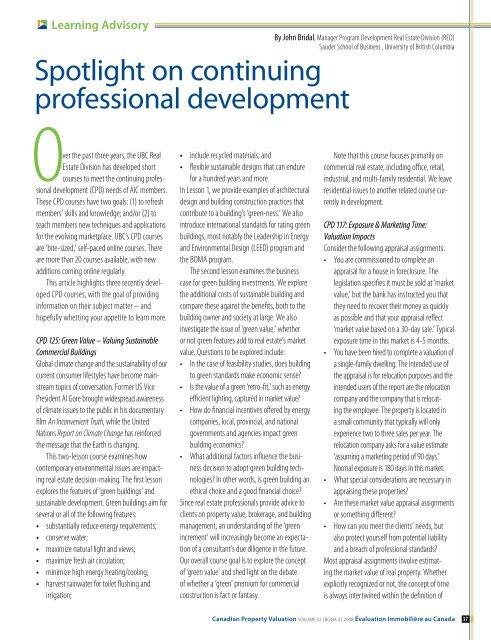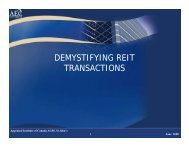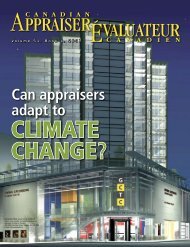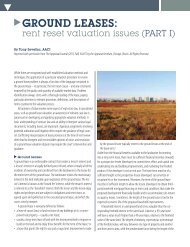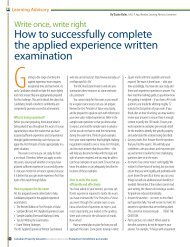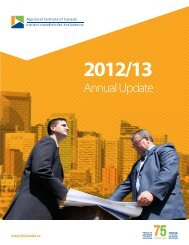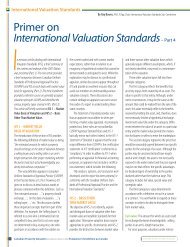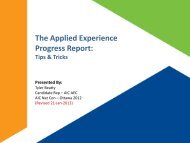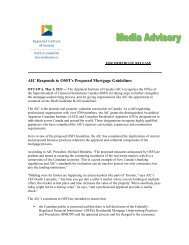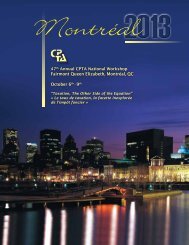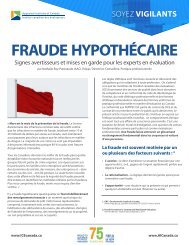Book 2 - Appraisal Institute of Canada
Book 2 - Appraisal Institute of Canada
Book 2 - Appraisal Institute of Canada
You also want an ePaper? Increase the reach of your titles
YUMPU automatically turns print PDFs into web optimized ePapers that Google loves.
Learning Advisory<br />
Spotlight on continuing<br />
pr<strong>of</strong>essional development<br />
O<br />
ver the past three years, the UBC Real<br />
Estate Division has developed short<br />
courses to meet the continuing pr<strong>of</strong>essional<br />
development (CPD) needs <strong>of</strong> AIC members.<br />
These CPD courses have two goals: (1) to refresh<br />
members’ skills and knowledge; and/or (2) to<br />
teach members new techniques and applications<br />
for the evolving marketplace. UBC’s CPD courses<br />
are ‘bite-sized,’ self-paced online courses. There<br />
are more than 20 courses available, with new<br />
additions coming online regularly.<br />
This article highlights three recently developed<br />
CPD courses, with the goal <strong>of</strong> providing<br />
information on their subject matter – and<br />
hopefully whetting your appetite to learn more.<br />
CPD 125: Green Value – Valuing Sustainable<br />
Commercial Buildings<br />
Global climate change and the sustainability <strong>of</strong> our<br />
current consumer lifestyles have become mainstream<br />
topics <strong>of</strong> conversation. Former US Vice<br />
President Al Gore brought widespread awareness<br />
<strong>of</strong> climate issues to the public in his documentary<br />
film An Inconvenient Truth, while the United<br />
Nations Report on Climate Change has reinforced<br />
the message that the Earth is changing.<br />
This two-lesson course examines how<br />
contemporary environmental issues are impacting<br />
real estate decision-making. The first lesson<br />
explores the features <strong>of</strong> ‘green buildings’ and<br />
sustainable development. Green buildings aim for<br />
several or all <strong>of</strong> the following features:<br />
• substantially reduce energy requirements;<br />
• conserve water;<br />
• maximize natural light and views;<br />
• maximize fresh air circulation;<br />
• minimize high energy heating/cooling;<br />
• harvest rainwater for toilet flushing and<br />
irrigation;<br />
• include recycled materials; and<br />
• flexible sustainable designs that can endure<br />
for a hundred years and more.<br />
In Lesson 1, we provide examples <strong>of</strong> architectural<br />
design and building construction practices that<br />
contribute to a building’s ‘green-ness.’ We also<br />
introduce international standards for rating green<br />
buildings, most notably the Leadership in Energy<br />
and Environmental Design (LEED) program and<br />
the BOMA program.<br />
The second lesson examines the business<br />
case for green building investments. We explore<br />
the additional costs <strong>of</strong> sustainable building and<br />
compare these against the benefits, both to the<br />
building owner and society at large. We also<br />
investigate the issue <strong>of</strong> ‘green value,’ whether<br />
or not green features add to real estate’s market<br />
value. Questions to be explored include:<br />
• In the case <strong>of</strong> feasibility studies, does building<br />
to green standards make economic sense?<br />
• Is the value <strong>of</strong> a green ‘retro-fit,’ such as energy<br />
efficient lighting, captured in market value?<br />
• How do financial incentives <strong>of</strong>fered by energy<br />
companies, local, provincial, and national<br />
governments and agencies impact green<br />
building economics?<br />
• What additional factors influence the business<br />
decision to adopt green building technologies?<br />
In other words, is green building an<br />
ethical choice and a good financial choice?<br />
Since real estate pr<strong>of</strong>essionals provide advice to<br />
clients on property value, brokerage, and building<br />
management, an understanding <strong>of</strong> the ‘green<br />
increment’ will increasingly become an expectation<br />
<strong>of</strong> a consultant’s due diligence in the future.<br />
Our overall course goal is to explore the concept<br />
<strong>of</strong> ‘green value’ and shed light on the debate<br />
<strong>of</strong> whether a ‘green’ premium for commercial<br />
construction is fact or fantasy.<br />
By John Bridal, Manager Program Development Real Estate Division (RED)<br />
Sauder School <strong>of</strong> Business , University <strong>of</strong> British Columbia<br />
Note that this course focuses primarily on<br />
commercial real estate, including <strong>of</strong>fice, retail,<br />
industrial, and multi-family residential. We leave<br />
residential issues to another related course currently<br />
in development.<br />
CPD 117: Exposure & Marketing Time:<br />
Valuation Impacts<br />
Consider the following appraisal assignments:<br />
• You are commissioned to complete an<br />
appraisal for a house in foreclosure. The<br />
legislation specifies it must be sold at ‘market<br />
value,’ but the bank has instructed you that<br />
they need to recover their money as quickly<br />
as possible and that your appraisal reflect<br />
‘market value based on a 30-day sale.’ Typical<br />
exposure time in this market is 4-5 months.<br />
• You have been hired to complete a valuation <strong>of</strong><br />
a single-family dwelling. The intended use <strong>of</strong><br />
the appraisal is for relocation purposes and the<br />
intended users <strong>of</strong> the report are the relocation<br />
company and the company that is relocating<br />
the employee. The property is located in<br />
a small community that typically will only<br />
experience two to three sales per year. The<br />
relocation company asks for a value estimate<br />
‘assuming a marketing period <strong>of</strong> 90 days.’<br />
Normal exposure is 180 days in this market.<br />
• What special considerations are necessary in<br />
appraising these properties?<br />
• Are these market value appraisal assignments<br />
or something different?<br />
• How can you meet the clients’ needs, but<br />
also protect yourself from potential liability<br />
and a breach <strong>of</strong> pr<strong>of</strong>essional standards?<br />
Most appraisal assignments involve estimating<br />
the market value <strong>of</strong> real property. Whether<br />
explicitly recognized or not, the concept <strong>of</strong> time<br />
is always intertwined within the definition <strong>of</strong><br />
Canadian Property Valuation Volume 52 | book 2 | 2008 Évaluation Immobilière au <strong>Canada</strong> 37


